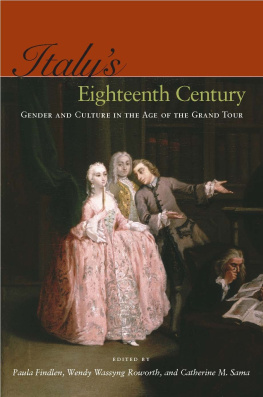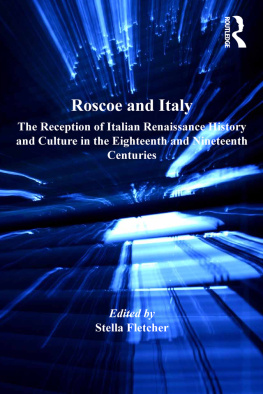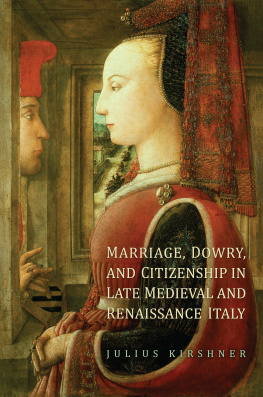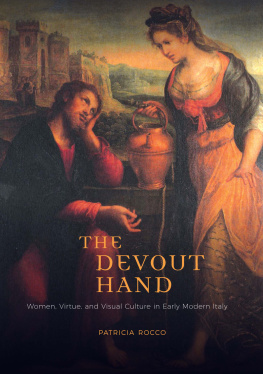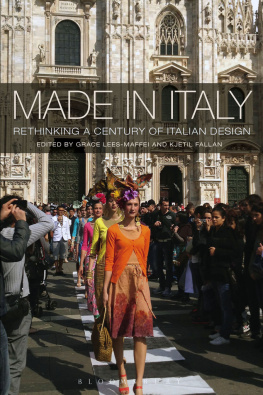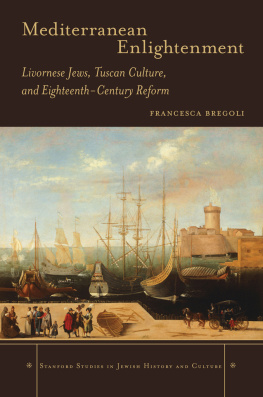This book is dedicated to our sisters Sharon, Susan, Emily, and Leslie and to sisterhood past, present, and future
Stanford University Press
Stanford, California
2009 by the Board of Trustees of the Leland Stanford Junior University.
All rights reserved.
This book has been published with the assistance of the University of Rhode Island Center for the Humanities and the School of Humanities and Science, Stanford University.
No part of this book may be reproduced or transmitted in any form or by any means, electronic or mechanical, including photocopying and recording, or in any information storage or retrieval system without the prior written permission of Stanford University Press.
Printed in the United States of America on acid-free, archival-quality paper
Library of Congress Cataloging-in-Publication Data
Italys eighteenth century : gender and culture in the age of the grand tour / edited by Paula Findlen, Wendy Wassyng Roworth, and Catherine M. Sama.
p. cm.
Includes bibliographical references and index.
9780804787543
1. ItalyIntellectual life18th century. 2. WomenItalyIntellectual life18th century. 3. Sex roleItalyHistory18th century. 4. ItalySocial life and customs18th century. I. Findlen, Paula. II. Roworth, Wendy Wassyng. III. Sama, Catherine M. DG447.I865 2009
945.07dc22
2008020030
Typeset by Bruce Lundquist in 10.5 /14 Adobe Garamond
Acknowledgments
This book developed from the conference Italys Eighteenth Century: Gender and Culture During the Age of the Grand Tour , held at the Getty Research Institute and William Andrews Clark Memorial Library, co-sponsored with the UCLA Center for 17th- and 18th-Century Studies in 2002. Louis Marchesano, collections curator of prints and drawings at the Getty Research Institute, co-organized the conference with Paula Findlen. Thomas Crow, director of the Getty Research Institute, Gail Feigenbaum, associate director of programs at the Getty, and Peter H. Reill, director of the UCLA Center for 17th- and 18th-Century Studies, all helped to make this a provocative and enjoyable event. We thank the staff of both institutions for making the event go so smoothly. Chloe Chard, Massimo Ciavolella, Carole Paul, and Geoffrey Simcox, who all participated in the conference, stimulated discussion that led to the idea of publishing the papers. More recently, Carole Paul served as the external reviewer for this manuscript and offered sage advice on its final composition.
We express our gratitude to them and to other colleagues, family, and friends who provided inspiration, encouragement, and support throughout the development of this interdisciplinary project. We would also like to thank Meredith Kunz for assistance with editing, Matthew Sneider for his translations of Italian essays, and Brian Brege for the index. Many institutions lent support, including the University of Rhode Island Center for the Humanities, Stanford University, the American Academy in Rome, the British School at Rome, the Getty Research Institute, the American Council for Learned Societies, the American Philosophical Society, and the Center for Advanced Study in the Behavioral Sciences. They offered material support for the completion of this project and sabbatical leave for two of the three editors.
The essays in this volume present original research by international scholars in fields ranging from the history of science, art, and music to literature, travel writing, and gender studies. Some were presented in earlier versions at the conference; other, new essays were included to broaden the scope of our theme. We would like to acknowledge the patience, cooperation, and generosity of all the authors who contributed essays to the book. Their enthusiasm for this project has made it a pleasure to complete.
We are especially appreciative of the care with which Stanford University Press has seen this project into print. Norris Pope, Emily-Jane Cohen, Judith Hibbard, and Tom Finnegan have all been a pleasure to work with. We thank them for their enthusiasm and understanding of the pleasures and importance of collaborative research.
During the course of this collaborative project, the editors learned a great deal from each other and the other authors about the women and men in these essays: their lives and loves, their successes and losses, and their contributions to letters, arts, and sciences in eighteenth-century Italy. As we prepared this volume, we experienced some joyous and some painful personal events of our ownthe birth of a child, the serious illness of a brother, the death of a beloved sister. Without the love and compassion of our families and friends, bringing our work to fruition would not have been possible.
Providence, Rhode Island, and Stanford, California
August 2008
INTRODUCTION
Gender and Culture in Eighteenth-Century Italy
PAULA FINDLEN
What you say about the Italians is what all foreigners say, what must strike them at first sight. But you must probe more deeply to judge this country.
Germaine de Stal, Corinne, or Italy (1807)
Touring Italy, Again
The voyage to Italy is the most interesting of all possible voyages, declared the abb Gabriel-Franois Coyer after his trip of 1763. In an era in which travel was a necessary part of a gentlemans education and increasingly a possibility for a handful of adventurous women, firsthand experience of Italy became an
Many thanks to Martha Feldman, Marta Cavazza, Carole Paul, and especially my coeditors, Catherine Sama and Wendy Wassyng Roworth, for generously sharing their knowledge of eighteenth-century Italy with me. Their comments and bibliographic suggestions have substantially improved the introduction as a reflection of a multidisciplinary conversation about the state of this field.
essential prerequisite to any claim to be a citizen of the world. A man who has not been to Italy, declared Samuel Johnson in 1776, is always conscious of an inferiority from his not having seen what it is expected a man should see.
Two years after Coyer completed his voyage, twenty-five-year-old James Boswell explained to Rousseau why he lingered in the southernmost parts of Europe: My desire to know the world made me resolve to intrigue a little while in Italy, he confessed.
While these representative travelers may not have agreed uniformly about how Italy would be the culmination of their education, they nonetheless concurred on the fundamental role of an Italian experience for eighteenth-century Britons and Europeans. In between their trips, for example, lay the imaginary journey of Ann Radcliffes English travelers, whose wanderings in Naples, set in about the year 1764, were the pretext for telling her melodramatic tale of love, family, honor, and Roman Catholic iniquity in The Italian (1796).
As even a casual perusal of eighteenth-century travel literature reveals, there were many ways to tour Italy.
Elisabeth Vige-Lebrun, Madame de Stal as Corinne , 1808. Erich Lessing/ Art Resource.


